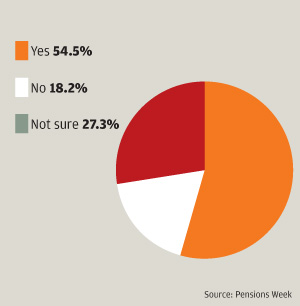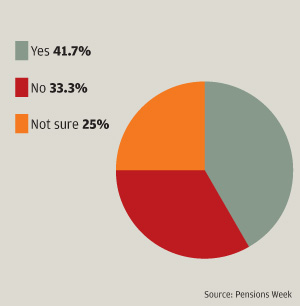DB 30: the end of DB for over 65s, the threat from longevity, and guidance from the regulator
Question 1. Do you think it is fair that employers are able to justify ending defined benefit accrual for those over the age of 65 as a result of the Seldon case, in which a law firm was able to dismiss a 65-year-old partner to create opportunities for younger workers?
More than half said yes, while more than a quarter weren’t sure, and a minority said no.
A high number of respondents approved of a proportionate approach that prevents the provision of more privileges to those already ‘blessed’ with DB arrangements, at the expense of those at the other end of the scale who are not so fortunate.
Others pointed out that many employers think attracting new talent is vital for the growth of their business, especially in the current challenging economic climate.
And one pointed to the fact DB accrual gets more expensive for older staff.
But a few, more sceptical respondents, branded the move as age discrimination, and said they are sure employers will eventually “get the hint” that it is illegal.
Question 2. The European Commission believes the UK’s pre-existing longevity and funding issues are a bigger threat than Solvency II. Do you agree with this statement?
Around 42% said the statement was fair, and a third disagreed, while the rest where unsure.
While they recognised UK DB schemes are riddled with problems, one warned: “Applying a Solvency II-type approach could potentially take the funding obligations of schemes to a whole new level.”
Another said: “The failure of the European Commission to engage and provide any sort of sensible consideration of impact is considerably more scary for DB scheme sponsors than the pre-existing issues (which themselves are, to an extent, the function of the domestic legislators failing to understand the nature of the DB ‘promise’ by attempting to guarantee everything).”
Some took a more cautious approach to the question, reminding us we still don’t know how Solvency II will be applied to the Institutions for Occupational Retirement Provision directive.
However, one added: “Assuming the financial aspects of Solvency II are imposed with no amendments, they will always add to the cost of providing benefits. So if UK pension schemes are still underestimating the effect of improvements in longevity, ultimately they will have to meet this cost – but Solvency II will make the cost even greater.”
One determined respondent disagreed, certain that “We will make sure the dreaded Europeans don’t impose the hard parts of Solvency II on pension funds.”
Question 3. The Pensions Regulator has just issued guidance for DB schemes operating in a tough economic climate. Do you think it has been lenient enough on schemes?
More than half said yes, while less than a fifth said no, and the rest were unsure.
Most described the guidance as pragmatic, and said the regulator has acted appropriately, but any given scheme will depend on its own particular circumstances.
One said: “It’s especially helpful that the regulator has stood down its narrow 10-year trigger, which was driving trustees to take too much risk, and encouraged them to use the ample flexibility within the regulatory framework.”
But others doubted whether the watchdog should be lenient on schemes at all. One suggested advisers should help trustees make the case for any leeway on recovery plans or technical provision calculation.
Another said: “Too much leniency would be abused”, while one argued it would serve little point if the regulator were to relax the funding standard as soon as the going gets tough.
And others were not satisfied the regulator has explored in sufficient detail the arguments about mean reversion and whether the stock markets are under or overvalued.
One said: “It is not clear the extent to which schemes that have given due consideration to funding in the context of the overall economic cycle will feel compelled to comply with the guidance.”
Another complained: “I wanted to see explicit recognition that an adjustment to technical provisions to deal with quantitative easing was acceptable.”
Most Viewed
- What does Labour have in store for the pensions industry?
- LGPS latest: GLIL backers invest £475m for UK infrastructure push
- Dashboard costs rose by 23% in 2023, figures show
- Border to Coast launches UK strategy in major private markets push
- How the pensions industry can better support people with mental health problems



